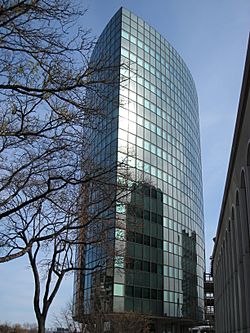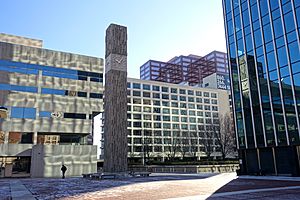Constitution Plaza facts for kids
Constitution Plaza is a large area in downtown Hartford, Connecticut. It has many different types of buildings, including offices, shops, and apartments. It's a well-known example of city planning from the mid-1900s.
Contents
Building Constitution Plaza
Constitution Plaza was built between 1962 and 1964. It cost $42 million to create. Local business leaders started the project. Later, the Travelers Insurance Company helped finish it.
This project was the first big effort to rebuild parts of Hartford. It replaced an old neighborhood called Front Street. This area used to flood often. It was known for its Italian-American families and many small shops and restaurants. Some people still debate if it was a good idea to tear down Front Street for the plaza.
Where is Constitution Plaza?
Constitution Plaza is on the east side of downtown Hartford. It is close to the famous Old State House. The plaza covers three city blocks. It includes office towers, shops, parking garages, and luxury apartments.
The buildings are connected by elevated walkways and bridges. The original plan was to connect the plaza to Hartford's Main Street. However, those bridges were never built.
Today, Constitution Plaza is connected to the Connecticut River. This connection was made possible by the Riverfront Recapture project. Now, you can walk from the plaza over Interstate 91 to a large riverside amphitheater and walkways. You can even cross the Connecticut River to East Hartford.
Cool Buildings and Design

Constitution Plaza shows off the style of commercial design from the mid-1900s. Architect Charles DuBose helped coordinate the overall design. The main office towers use lots of glass.
Some of the important buildings are:
- One Constitution Plaza (built 1961-1963)
- 100 Constitution Plaza (built 1961)
- 200 Constitution Plaza (architects unknown)
- 250 Constitution Plaza (built 1962-1963)
- Phoenix Life Insurance Company Building (built 1962-1964)
The Phoenix Life Insurance Company Building is very special. People sometimes call it "the boat building" because of its shape. It has unique blue-green glass and is known for being "two-sided." It's seen as one of Connecticut's best modern buildings. The Connecticut Science Center is also next to Constitution Plaza.
There was once a building called Broadcast House. It was home to the local CBS TV station, WFSB-TV, until 2007. Another building, which used to be a hotel, closed for a long time. It reopened in 2015 as luxury apartments called Spectra.
The plaza has beautiful outdoor spaces. These include walkways, gardens, a clock tower, and fountains. These were designed by landscape architect Masao Kinoshita. The entire plaza sits on top of a large parking garage for 1,600 cars.
Constitution Plaza was once seen as the future of city design. It helped bring new life to downtown Hartford.
Events at the Plaza
Constitution Plaza used to host many public events each year. One popular event was the Festival of Lights during the holiday season. This festival has since moved to Bushnell Park. The plaza also hosted concerts and food festivals like the Taste of Hartford.


